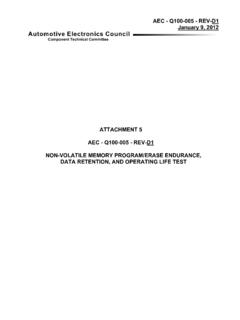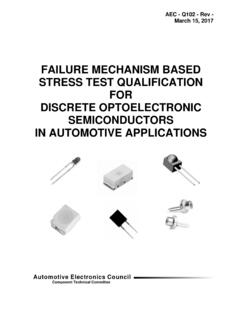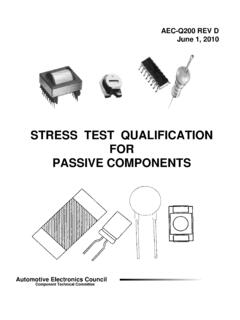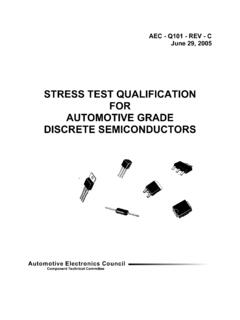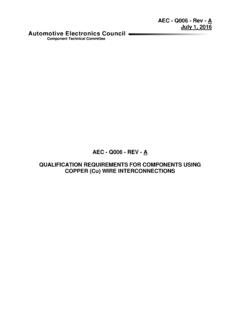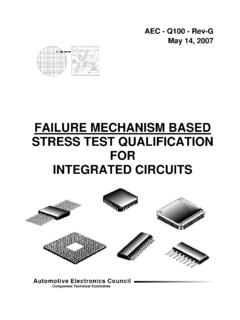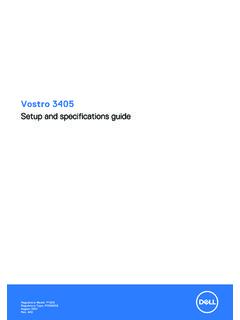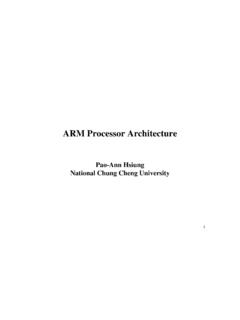Transcription of GUIDELINE FOR CHARACTERIZATION OF INTEGRATED …
1 AEC - Q003 Rev-A February 18, 2013 Component Technical CommitteeAutomotive Electronics Council GUIDELINE FOR CHARACTERIZATION OF INTEGRATED CIRCUITS AEC - Q003 Rev-A February 18, 2013 Component Technical CommitteeAutomotive Electronics Council Acknowledgment Any document involving a complex technology brings together experience and skills from many sources. The Automotive Electronics Counsel would especially like to recognize the following significant contributors to the development and release of this document: CHARACTERIZATION Sub-Committee Members: Tim Haifley Altera Sandra Healy Analog Devices Michael O Sullivan Analog Devices Xin Miao Zhao [Q003 Team Leader] cirrus logic Ramon Aziz Delphi Corporation Paul Grosch Freescale Nick Lycoudes Freescale Laurie McTurk Freescale James Stanley Freescale Drew Hoffman Gentex Richard Lauks Infineon Harold Lorenz Infineon Jochen Roeder Infineon Tim Weyland Infineon Banjie Bautista ISSI Gary Fisher Johnson Controls Bob Knoell NXP Yizi Xing NXP David Ownby SMSC Joel Dobson Texas Instruments Thomas VanDamme TRW Daniel Chung Xilinx AEC - Q003 Rev-A February 18, 2013 Component Technical CommitteeAutomotive Electronics Council NOTICE AEC documents contain material that has been prepared, reviewed, and approved through the AEC Technical Committee.
2 AEC documents are designed to serve the automotive electronics industry through eliminating misunderstandings between manufacturers and purchasers, facilitating interchangeability and improvement of products, and assisting the purchaser in selecting and obtaining with minimum delay the proper product for use by those other than AEC members, whether the standard is to be used either domestically or internationally. AEC documents are adopted without regard to whether or not their adoption may involve patents or articles, materials, or processes. By such action AEC does not assume any liability to any patent owner, nor does it assume any obligation whatever to parties adopting the AEC documents.
3 The information included in AEC documents represents a sound approach to product specification and application, principally from the automotive electronics system manufacturer viewpoint. No claims to be in conformance with this document shall be made unless all requirements stated in the document are met. Inquiries, comments, and suggestions relative to the content of this AEC document should be addressed to the AEC Technical Committee on the link Published by the Automotive Electronics Council. This document may be downloaded free of charge, however AEC retains the copyright on this material. By downloading this file, the individual agrees not to charge for or resell the resulting material. Printed in the All rights reserved Copyright 2013 by the Automotive Electronics Council.
4 This document may be freely reprinted with this copyright notice. This document cannot be changed without approval from the AEC Technical Committee. AEC - Q003 Rev-A February 18, 2013 Component Technical CommitteeAutomotive Electronics Council Page 1 of 18 GUIDELINE FOR THE CHARACTERIZATION OF INTEGRATED CIRCUITS Text enhancements and differences made since the last revision of this document are shown as underlined text. 1. PURPOSE The CHARACTERIZATION of ICs is an extremely important function during the development of a new IC or the modification of an existing IC. The purpose of this document is to provide guidance by highlighting important considerations that should be evaluated during development of a CHARACTERIZATION procedure.
5 This document is not intended to be a specification on how to perform a CHARACTERIZATION . To ensure consistent CHARACTERIZATION every company should have a structured and documented CHARACTERIZATION procedure. The CHARACTERIZATION process should be used to ensure that the design and wafer fab/assembly processes being utilized demonstrate sufficient capability of providing a part that meets the requirements of the customer. The results of every CHARACTERIZATION should be documented in a CHARACTERIZATION Report. 2. SCOPE This GUIDELINE document provides the basis for establishing a procedure for characterizing the electrical performance of INTEGRATED Circuit products. This CHARACTERIZATION procedure should be used for new technologies, new wafer fabrication processes, new product designs, and change in bill of material, manufacturing location and significantly modified ICs.
6 This full scale CHARACTERIZATION is a procedure to assess a new product line, including establishing supplier datasheet limits. For qualification of a product with established supplier datasheet limits, please reference AEC-Q100-009 Electrical Distributions Assessment procedure. 3. DEFINITIONS ANOVA Analysis of variance between groups. CHARACTERIZATION The process of determining the fundamental electrical and physical characteristics of a device based on statistical analysis of experimental data modeling. The input is batches of newly manufactured INTEGRATED circuit parts subjected to CHARACTERIZATION sampling and the output is a data set. The result is to prove or disprove that the devices can and will continue to perform their targeted functions according to the product definition.
7 Data resulted from CHARACTERIZATION are used to specify datasheet limits and functions. It is important to determine the ESD and Latch-up capability of a part early in the development cycle as these parameters could have a significant impact on the performance of the part. AEC - Q003 Rev-A February 18, 2013 Component Technical CommitteeAutomotive Electronics Council Page 2 of 18 Cpk A measure of the relationship between the specification limits and the capability. Reference: PPAP Manual Fourth Edition, see SPC Manual. Criteria for CHARACTERIZATION A device that meets the following criteria should be considered a candidate for CHARACTERIZATION . These criteria should not be considered a limitation, but a starting point for factors to consider.
8 New product design. New device layout or changes to an existing device that could impact electrical parameters. New cell structure(s) which have not been used in production components. New processing methods or materials. New operating bias condition requirements (re-characterize at new bias extremes). New operating environmental conditions (such as voltage and temperatures). Device Electrical Parameters Electrical parameters specified in the part specification for the device. Guardband The difference between limits used for screening ( , CHARACTERIZATION , production testing, etc.) and specification limits. Guardbands are used to account for repeatability and reproducibility issues. LSL Lower Specification Limit.
9 Matrix Lot Matrix lot is a lot composed of wafers that are based on manufacturing site s process of records and manufactured to the process corners for identifying design/process weakness and improvement as well as indicating yield sensitivity corners. PPM Part Per Million. In this document the PPM is the probability the parameter will be outside of product specification limits. Specification Limits ( , Data Sheet Limits) Numerical values of maximum, minimum, and typical for electrical parameters specified in supplier s data sheet or customer s part specification. These values are used to determine pass/fail criteria for device CHARACTERIZATION and production testing. AEC - Q003 Rev-A February 18, 2013 Component Technical CommitteeAutomotive Electronics Council Page 3 of 18 Standard Deviation Standard deviation or sigma is a measure of how widely values are dispersed from the average value (the mean).
10 USL Upper Specification Limit. 4. CHARACTERIZATION PROCEDURE An outline of factors that should be considered when establishing a CHARACTERIZATION procedure is provided here for every supplier to establish a CHARACTERIZATION procedure. The Device CHARACTERIZATION Process Flow is shown in Figure 1. Device CHARACTERIZATION Plan The CHARACTERIZATION plan should include the following major activities for the device to be characterized: Review the CHARACTERIZATION Checklist, see Appendix 1. Determination of if a matrix lot is necessary for the device CHARACTERIZATION . Determination of the CHARACTERIZATION method to be used.
